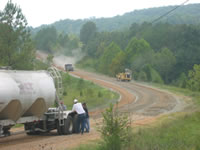 A severely deteriorated roadway in northwestern Alabama was recently rehabilitated through the Full-Depth Recycling (FDR) process. David Palmer, county engineer, Franklin County Highway Department, had one particular roadway that had become a maintenance headache for his agency and had been searching for new ways to create a more durable roadway that could support his County's increasing traffic loads. Palmer met with individuals from the Portland Cement Association, the American Concrete Pavement Association, and National Cement Company of Alabama to hear about FDR and what it could mean for his roadways. Upon hearing the positive news of both durability and economy using full-depth reclamation, Palmer agreed to the process and a 1.7-mile stretch of Franklin County Highway 84 just north of Cedar Lake became the first known FDR project in the state of Alabama incorporating portland cement.
A severely deteriorated roadway in northwestern Alabama was recently rehabilitated through the Full-Depth Recycling (FDR) process. David Palmer, county engineer, Franklin County Highway Department, had one particular roadway that had become a maintenance headache for his agency and had been searching for new ways to create a more durable roadway that could support his County's increasing traffic loads. Palmer met with individuals from the Portland Cement Association, the American Concrete Pavement Association, and National Cement Company of Alabama to hear about FDR and what it could mean for his roadways. Upon hearing the positive news of both durability and economy using full-depth reclamation, Palmer agreed to the process and a 1.7-mile stretch of Franklin County Highway 84 just north of Cedar Lake became the first known FDR project in the state of Alabama incorporating portland cement.
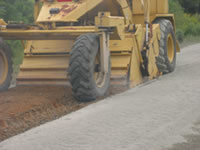 With all the necessary preliminary sampling and testing completed, roadway construction activities began on September 18, 2002. The cement was delivered to the project in bulk tankers where it was applied directly on top of the roadway at an application rate of approximately 37 pounds per square yard - a rate that equated to the 5 percent as determined during the Mix Design process. Through one pass of a Caterpillar RR-250 reclaimer, the existing roadway and underlying soils were pulverized and blended together with the portland cement. Water trucks applied water to this blended material, bringing it to its required optimum moisture. One additional pass with the reclaimer resulted in a homogenous roadway base material.
With all the necessary preliminary sampling and testing completed, roadway construction activities began on September 18, 2002. The cement was delivered to the project in bulk tankers where it was applied directly on top of the roadway at an application rate of approximately 37 pounds per square yard - a rate that equated to the 5 percent as determined during the Mix Design process. Through one pass of a Caterpillar RR-250 reclaimer, the existing roadway and underlying soils were pulverized and blended together with the portland cement. Water trucks applied water to this blended material, bringing it to its required optimum moisture. One additional pass with the reclaimer resulted in a homogenous roadway base material.
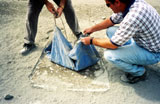 The roadway was shaped to the appropriate line, grade, and cross-sections using a Caterpillar 12H motor grader and then compacted using a Caterpillar CP563C vibratory sheepsfoot roller and a Caterpillar CS563C vibratory smooth drum roller. A nuclear density gauge was used at numerous locations throughout the project to ensure that a minimum density of 96 percent (as determined during the laboratory evaluation) was successfully obtained. The roadway was then kept continuously moist through repeated applications of water by the water truck to ensure that the cement-stabilized roadway cured properly and attained its desired strength. The final step in the construction process was the later application of a double bituminous surface treatment.
The roadway was shaped to the appropriate line, grade, and cross-sections using a Caterpillar 12H motor grader and then compacted using a Caterpillar CP563C vibratory sheepsfoot roller and a Caterpillar CS563C vibratory smooth drum roller. A nuclear density gauge was used at numerous locations throughout the project to ensure that a minimum density of 96 percent (as determined during the laboratory evaluation) was successfully obtained. The roadway was then kept continuously moist through repeated applications of water by the water truck to ensure that the cement-stabilized roadway cured properly and attained its desired strength. The final step in the construction process was the later application of a double bituminous surface treatment.
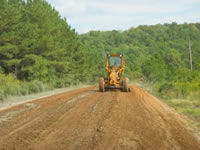
Shaping roadway
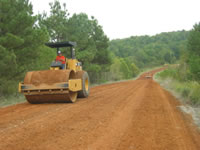
Compacting roadway

Curing roadway
As in the case of Franklin County Highway 84, portland cement is the key to reconstructing flexible pavements that have failed. The incorporation of portland cement with the old base course material, often including the old asphalt surface, provides a practical, cost-effective means of strengthening worn-out pavements. The cement binds the particles together to form a stabilized base material capable of withstanding moisture infiltration and degradation. It increases the strength of the base without the need for removing the old material and hauling in large quantities of expensive new base materials.
The success of the Franklin County project is paving the way for greater acceptance of FDR in Alabama as an economical process for long-term road rehabilitation. In fact, an FDR project was constructed in a Trussville, Alabama subdivision in Jefferson County in April of this year and the Alabama Department of Transportation is currently in the process of finalizing their plans for their first full-depth reclamation project to be let later this summer.